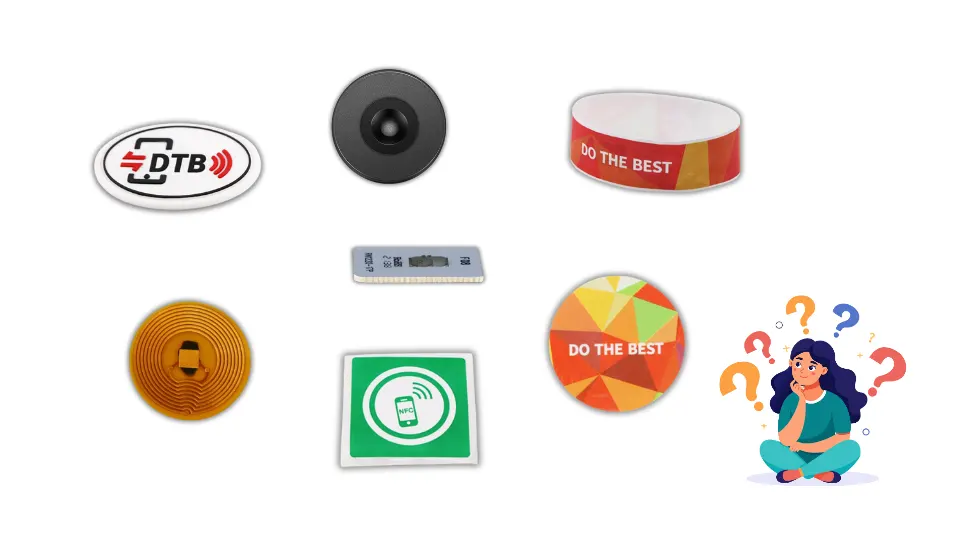
For businesses looking to integrate NFC into their operations—whether for retail, events, asset tracking, or product authentication—choosing the right tag can make all the difference.
Different NFC tag types are built from different materials, each optimized for particular environments, durability, or aesthetics. In this article, we’ll break down the most common types of NFC tag materials and explore which scenarios they best serve—so you can make a confident, informed decision.
Paper-based NFC tags are low-cost, thin, and ideal for one-time or short-term interactions. They’re often found embedded in product packaging, printed flyers, or event tickets. Their flexibility and affordability make them popular for marketing campaigns, such as linking a customer to a promotional video or survey.
However, they’re not designed to survive rough environments or frequent handling. Exposure to water, abrasion, or heat can quickly degrade them.
Best for: Disposable packaging, print ads, coupons, giveaways.
PET (polyethylene terephthalate) NFC tags strike a balance between durability and form factor. These tags often come in sticker form and are widely used in retail environments, library books, or warehouse management where occasional scanning is required.
Thanks to their transparency and flexibility, PET tags can be laminated into labels or embedded behind logos or stickers on products without affecting design aesthetics.
Ideal when: You need discreet but resilient tagging on product surfaces.
PVC-based NFC cards are commonly used for access control, identification, and loyalty systems. They’re the size of a standard credit card and can be printed with branding or personal details. Businesses such as gyms, coworking spaces, and hotels often issue them as keycards or membership passes.
PVC cards are water-resistant and quite durable, but they’re not suitable for small objects or surfaces where size matters.
Think about: Access badges, event passes, ID verification.
Epoxy-coated tags are a favorite for branding-oriented applications. They offer a glossy, premium look while being waterproof and scratch-resistant. You’ll often see these tags used on keychains, smart jewelry, or high-end promotional merchandise.
The tradeoff is that epoxy tags are typically more expensive and less flexible than PET or paper tags.
Best suited for: Promotional gifts, smart accessories, brand engagement.
ABS plastic NFC tags are built to endure. They’re often used in outdoor settings, industrial environments, or anywhere the tag might be exposed to impacts, UV, chemicals, or extreme temperatures. These tags can be riveted, screwed, or glued onto metal or plastic surfaces.
Factories use ABS NFC tags to identify tools, track pallets, or control access to equipment. They’re also popular in bicycle-sharing programs or parking systems.
Rugged choice for: Industrial, automotive, outdoor applications.
When you need mobility, silicone wristband NFC tags are the go-to. They’re comfortable to wear, waterproof, and widely used in amusement parks, concerts, and fitness centers. Wristbands can enable fast access, contactless payments, or even real-time activity tracking.
They come in many styles and colors and can be customized with branding or variable data (like guest names or access levels).
Ideal for: Festivals, sports events, theme parks, swimming pools.
Fashion-forward companies are experimenting with fabric NFC tags sewn into clothing or accessories. These tags enable everything from digital storytelling to counterfeit prevention. A luxury brand might embed an NFC tag into a handbag lining that, when tapped, verifies authenticity and shares the item’s craftsmanship story.
They’re also being used in hotel linen tracking and uniform management systems.
Perfect for: Fashion, supply chain tracking, authenticity assurance.

Standard NFC tags often fail when placed on metal surfaces due to interference. On-metal NFC tags are designed with ferrite backing to block such disruption, making them reliable for tagging laptops, machinery, tools, or metal containers.
They’re essential for inventory management in tech stores, industrial settings, or anywhere metal surfaces are involved.
Great for: IT asset tagging, equipment maintenance, metal packaging.
For industries concerned with product integrity—like pharmaceuticals, electronics, or wine—tamper-evident NFC tags offer peace of mind. These tags are designed to break or disable themselves once removed, ensuring a product has not been opened or altered.
Customers can verify authenticity and security with a simple tap, making them valuable in anti-counterfeit strategies.
Use them for: Secure packaging, luxury items, compliance-sensitive goods.
In niche applications such as livestock tracking or lab sample monitoring, NFC tags in glass capsule form are inserted under skin or embedded into non-organic material. Though more often seen with RFID, NFC variants exist for pet identification or high-value item embedding.
Their applications are narrow but critical for traceability.
Best for: Medical, veterinary, or embedded asset tracking.
Matching Tags to Business Strategy
Choosing the right NFC tag isn’t just about material—it’s about understanding your environment, goals, and customer interaction. A retail store running a short-term campaign might lean toward paper NFC stickers for shelf-edge promotion, while a high-end brand may require epoxy tags embedded into packaging for aesthetic and durability.
Ask yourself:
Will the tag be reused or disposed of?
Is water, abrasion, or metal nearby?
Will the user scan it with a phone, reader, or terminal?
Is branding or invisibility more important?
By aligning your tag choice with your real-world needs, you ensure your NFC deployment is not just technically functional—but customer-friendly, efficient, and future-proof.
Copyright ©2025 Shenzhen DTB RFID Co., Ltd. All Rights Reserved.